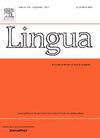有生命性如何影响奥地利手语的语序(ÖGS):来自无生命主语论证的句子的证据
IF 1.3
3区 文学
0 LANGUAGE & LINGUISTICS
引用次数: 0
摘要
跨语言证据表明,事件参与者的活力可能会影响语言生成中的句法结构。本研究考察了动画对词序的影响,以及之前观察到的奥地利手语中对主体首字母顺序的偏好(ÖGS)。因此,用生产任务测试了两组具有无生命主论点的及物句的语序。特别地,在有一个无生命的主语和一个有生命的宾语的结构中,以及在有两个无生命的论点的句子中,研究了语序。聋哑流利的手语者被要求在刺激物引发的事件描述上签名,这些事件描述包括一张说明主体论点的图片,一张显示客体论点的图片,以及一个以书面形式呈现的动词。数据分析为SOV作为ÖGS中的基本顺序提供了支持,并证明了主语偏好的鲁棒性,即使在具有无生命主语参数的句子中也是如此。此外,虽然在ÖGS中,动画并没有超越主题偏好,但数据表明,它仍然可能影响该语言中的词序。本文章由计算机程序翻译,如有差异,请以英文原文为准。
How animacy impacts word order in Austrian Sign Language (ÖGS): Evidence from sentences with inanimate subject arguments
Cross-linguistic evidence shows that the animacy of event participants may impact the syntactic structure in language production. This study examines the effect of animacy on word order and the previously observed preference for subject-initial orders in Austrian Sign Language (ÖGS). Therefore, word order in two sets of transitive sentences with inanimate subject arguments was tested by a production task. In particular, word order was examined in structures with an inanimate subject and an animate object argument, as well as in sentences with two inanimate arguments. Deaf fluent signers were asked to sign event descriptions elicited by stimuli that included a picture illustrating the subject argument, a picture showing the object argument, and a verb presented as a written gloss. Data analysis provides support for SOV as the basic order in ÖGS and demonstrates the robustness of the subject preference, even in sentences with inanimate subject arguments. Furthermore, while animacy does not override the subject preference in ÖGS, the data suggest that it may still influence word order in this language.
求助全文
通过发布文献求助,成功后即可免费获取论文全文。
去求助
来源期刊

Lingua
Multiple-
CiteScore
2.50
自引率
9.10%
发文量
93
审稿时长
24 weeks
期刊介绍:
Lingua publishes papers of any length, if justified, as well as review articles surveying developments in the various fields of linguistics, and occasional discussions. A considerable number of pages in each issue are devoted to critical book reviews. Lingua also publishes Lingua Franca articles consisting of provocative exchanges expressing strong opinions on central topics in linguistics; The Decade In articles which are educational articles offering the nonspecialist linguist an overview of a given area of study; and Taking up the Gauntlet special issues composed of a set number of papers examining one set of data and exploring whose theory offers the most insight with a minimal set of assumptions and a maximum of arguments.
 求助内容:
求助内容: 应助结果提醒方式:
应助结果提醒方式:


